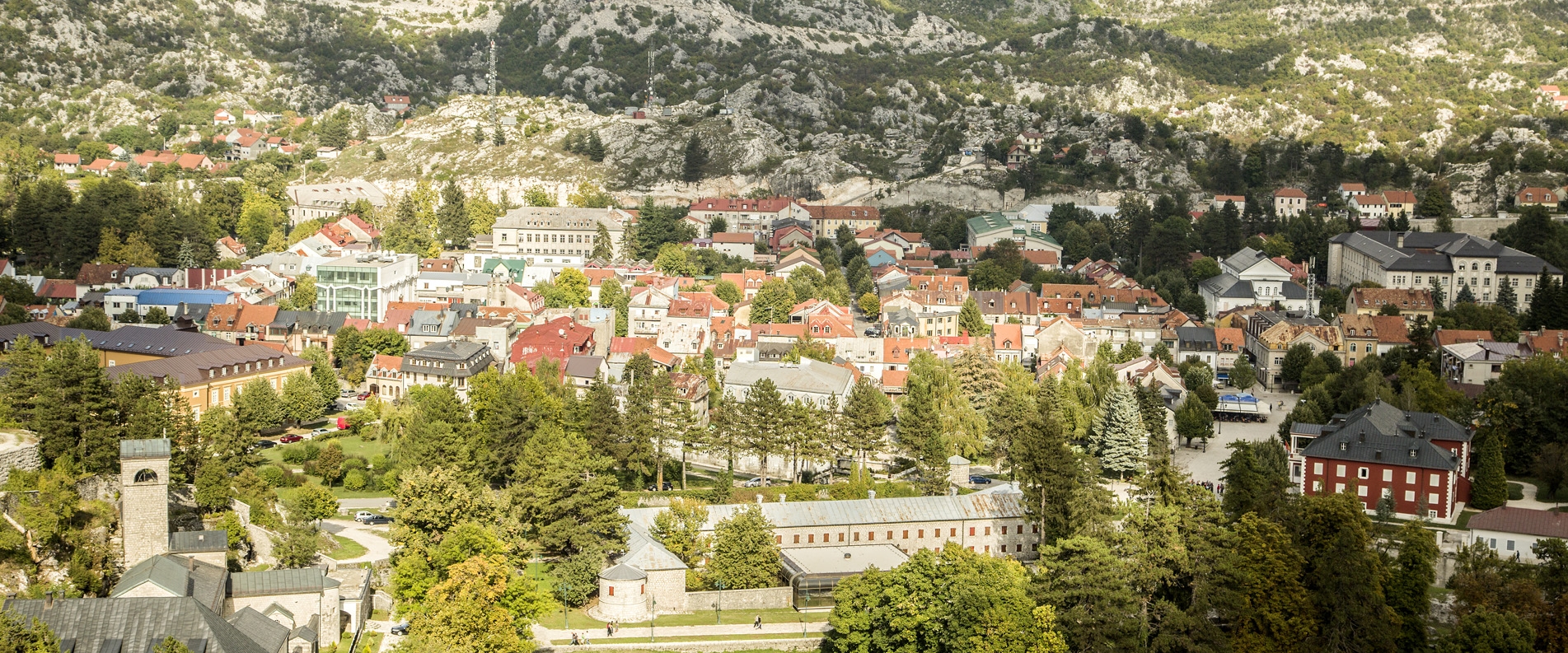Cetinje is the old capital of Montenegro, the heart of the state, beautiful city, hidden from the coast in the Lovcen National Park.
We will tell you about the most interesting architectural, historical and religious monuments of Cetinje; why the royal capital was located so far from the sea; how to find an amazing Lipa Cave and go through an obstacle course in the Lovcen Adventure Park; and much more.
Geographical location and climate
The city of Cetinje is located on a plateau at the slope of the Lovcen mountain between the Boka Kotorska (the bay on the Adriatic Sea, where the cities of Kotor, Risan, Tivat and Herceg Novi are located) and the Lake Skadar (the lake between Montenegro and Albania, the largest on Balkans). It stands at an altitude of 650 meters (2133 feet) above sea level.
Direct distance from Cetinje to the seaside town of Budva is 14 kilometers (9 miles), 31 kilometers (19 miles) by highway; and 44 kilometers (27 miles) if you choose the historical road to the coastal Kotor.
Despite its proximity to the sea, the climate in Cetinje is very different from the climate on coastline, it is more continental then Mediterranean.
In summer the city is warm, but not exhaustingly hot, the average daily temperature is about 20 degrees Celsius (60 Fahrenheit). Winter is cold here, with sub-zero temperatures and heavy snowfalls. Spring and autumn are very humid, 4000 millimeters (157.5 inches) average yearly rainfall makes Cetinje one of the wettest cities in Europe.
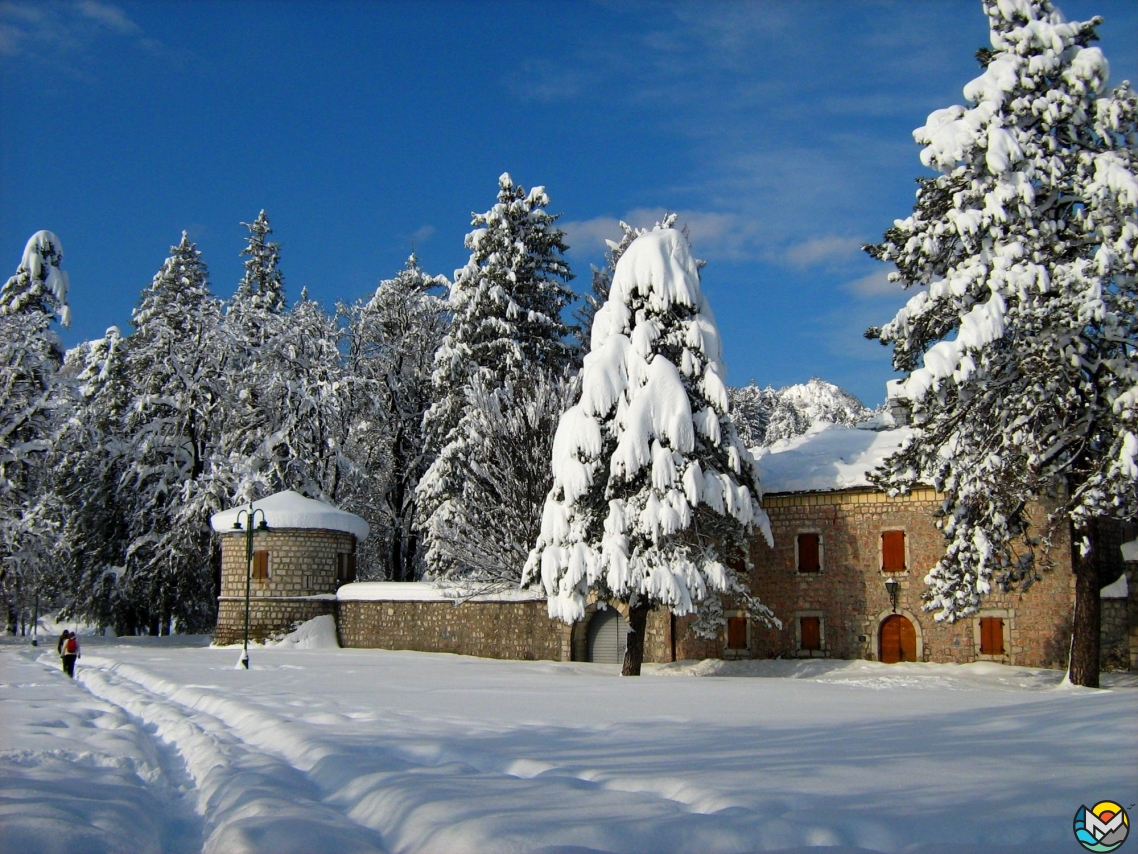
As for transport accessibility, Cetinje is connected by bus routes with Podgorica, the capital of Montenegro, coastal cities and neighboring Serbia. You can easily get there by car or with excursion group, Cetinje is a very popular tourist city.
History of Cetinje
Cetinje was founded more recent than the coastal cities, in 1484, by the ruler of the Principality of Zeta (the name Montenegro did not exist yet) Ivan I Cernojević. The ancient capitals were located before on Lake Skadar — first in Zabljak, then on Obod (Rijeka Crnojevića) — but both were seized by the Turks. The ruler had no choice, but to go higher up in the mountains and set a city there. Later this place was called the mountain of Cernojević. Crn means “black”, and this is one of the versions, why the country is called Montenegro, Black Mountain.
Fortifications and the Cetinje Monastery were later built in the city. The Monastery had become the residence of the rulers of Metropolitanate of Montenegro and the Littoral.
The son of Ivan I Cernojević, Đurađ Crnojević opened printing house here — the first in the Balkans.
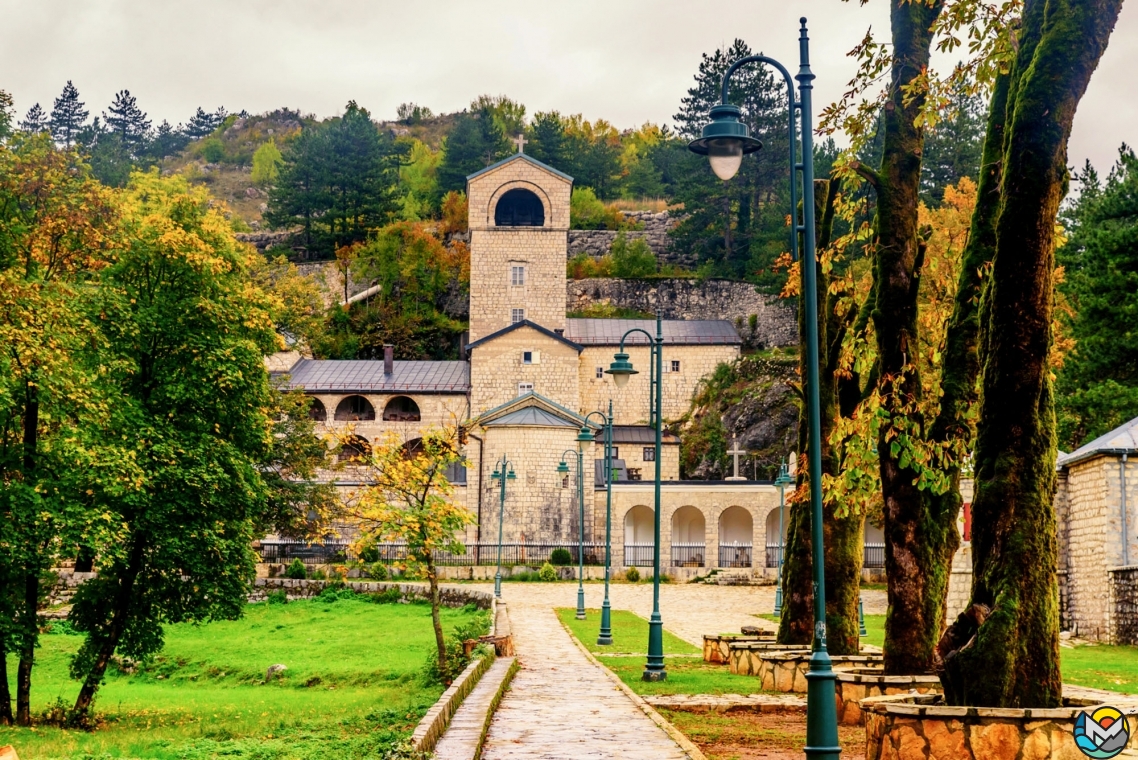
The printing press came from Venice. In 1494 the first Slavic Cyrillic printed book in the Balkans — Oktoih — was published in Cetinje.
But the typography did not last long. In the 17th century, the city was at the very center of the confrontation between Ottomans and Venetians. The Monastery was destroyed, and Cetinje was left in a sad state of disrepair. In memory of typography you can see a book on the modern emblem of the city.
The revival of Cetinje began in 18th century, when the theocratic principality of Montenegro was headed by Metropolitan Danilo I Petrović-Njegoš. He oversaw a restoration of the Cetinje Monastery, palaces and fortifications. But throughout its history, Cetinje was destroyed and rebuilt many times.
-
In 1834 a school was opened at the Cetinje Monastery, and soon the printing house began to operate.
Montenegrin independence was recognized at the Congress of Berlin of 1878, and consequently Cetinje became the capital of the country. Numerous government buildings were constructed at that time, and luckily they are well-preserved until now.
Cetinje thrived until the First World War, when Montenegro lost its independence, and the king fled the country. After that, the city did not restore its capital functions, neither in the kingdom of Yugoslavia nor in the SFRY. Podgorica had become the main city of Montenegro.
Following the independence referendum in 2006 (the country left the union state of Serbia and Montenegro), Cetiné was recognized as one of two capitals: the residence of the president and the Ministry of Culture are located here.
Several years later, the city authorities agreed to build a residence for a descendant of fugitive Montenegrin king Nikola I Petrović-Njegoš, his great-grandson Prince Nikola II Petrović-Njegoš, who lives in France, but visits the land of ancestors. In 2011 the Montenegrin Parliament recognized the status of the Montenegrin royal house of Petrović-Njegoš.
Top sights of Cetinje
Churches and Monasteries
Because of its rich history and modest size, there are many monuments of architecture, secular and religious, in Cetinje, and they are in proximity to each other.
We have to start with the Cetinje Monastery, contemporary of the city. As mentioned earlier, it was destroyed many times and it acquired its present appearance after 1743, although there were later renovations. The Monastery houses important Orthodox relics — Right Hand of John the Baptist, remains of Petar I Petrović-Njegoš, particles of the True Cross. The monastery is open to all believers and pilgrims.
The Church of the Nativity of The Blessed Virgin Mary at the heart of the Monastery was built by order of Petar I Petrović-Njegoš.
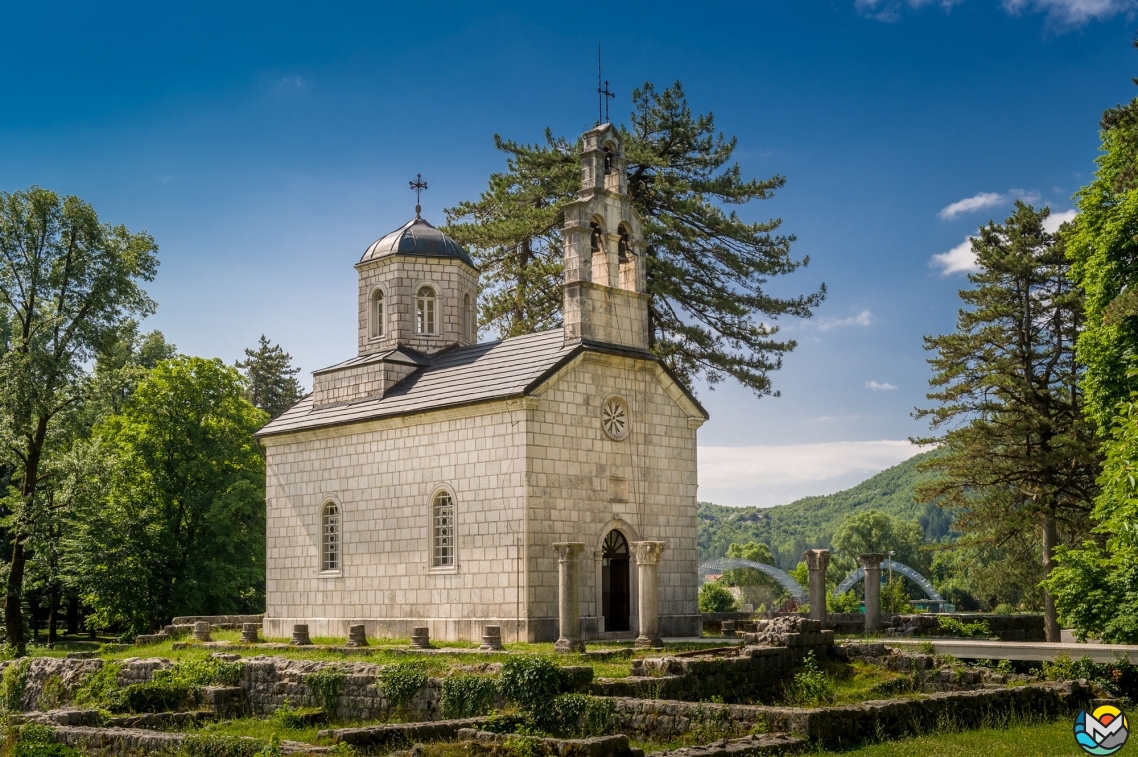
The Vlah Church deserves a special attention: along with the Cetinje Monastery it is the oldest structure in the city. It was built around 1450, but repeatedly destroyed during the Ottoman occupation and attained its modern look in 1864.
A fence around the church was constructed from the gun barrels of Ottoman rifles captured during the war of liberation in 1858–1878. In this church, the king of Montenegro, Nikola I Petrović-Njegoš and his wife Milena got married.
Above the city, on the beautiful Orlov cliff, is the mausoleum of Danilo I, Metropolitan of Cetinje.
Museums
The former Montenegrin government building (Vladin dom) houses the Museum of Fine Arts and History Museum. There are works of Montenegrin artists, a collection of icons of the Russian, Italian and Greek masters, and copies of the frescoes of the local churches.
The pearl of the collection is Filermosa, an exceptionally valuable icon of Virgin Mary created in year 46 AD. The holy artifact traveled through history to finally reach its resting place in the museum’s Blue Chapel.
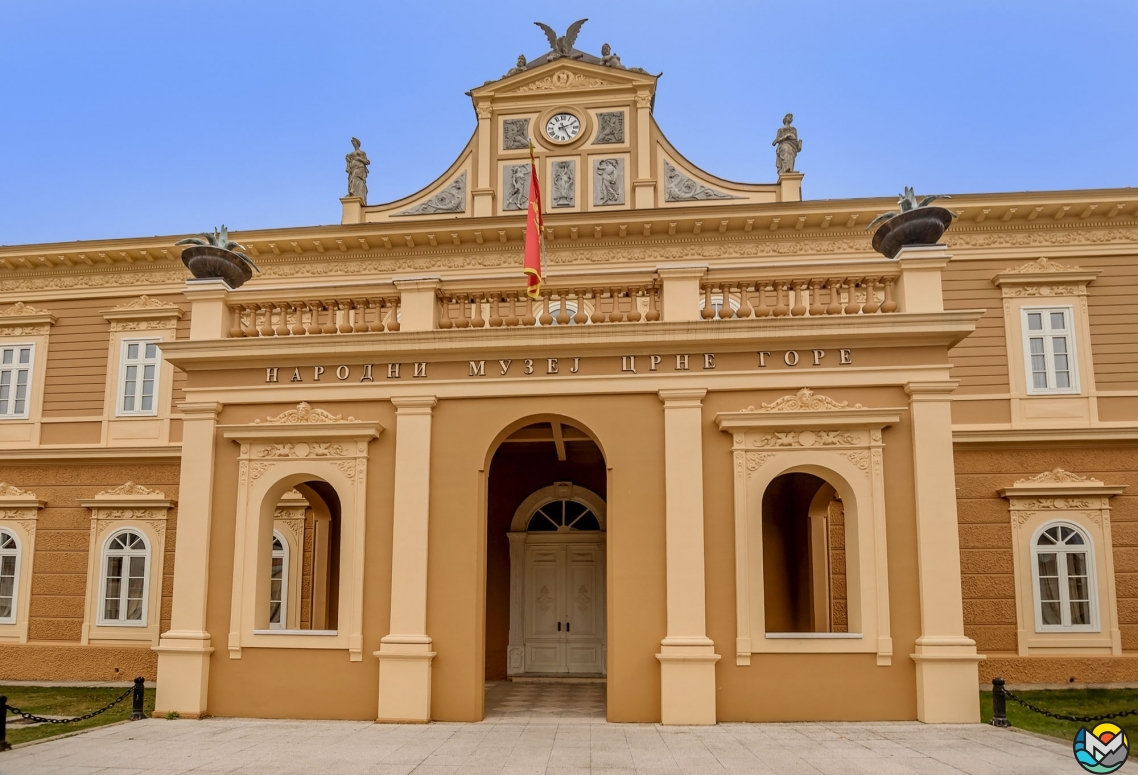
The permanent exhibition of the museum consists of the paintings and sculptures of Balkan artists and masterpieces of Picasso, Chagall, Dali, Renoir.
Collections of the History Museum introduce you to the history of the country from ancient times to the present day.
The graceful building of the former Serbian Embassy now houses the Ethnographic Museum of Montenegro. Items on display include the best pieces of clothing and other things for everyday or festive use, most of them date from XIX – early XX centuries.
At the residence of the last Montenegrin ruler, king Nikola I Petrović Njegoš, a museum was founded in 1926, and its permanent collection provides an insight into the life and habits of the Montenegrin Royal family.
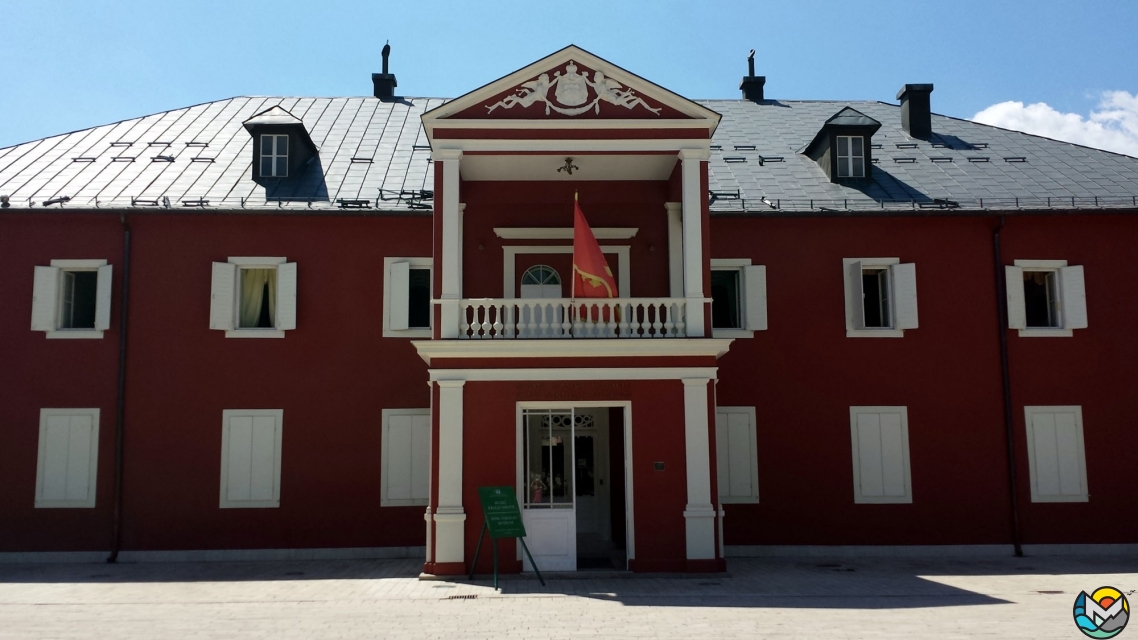
Unlike the refined architecture of King Nikola's palace, Biljarda Museum resembles a fortress, surrounded by a stone wall. It was built in 1838 for prince-bishop and poet Petar II Petrović-Njegoš.
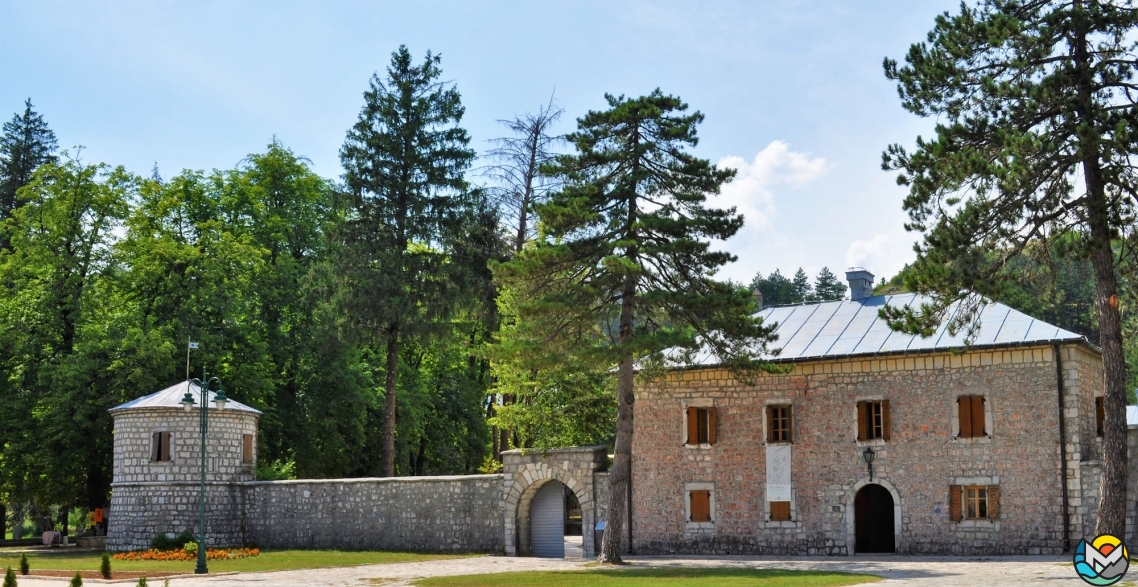
The museum exhibits the personal effects of the ruler, his documents, furniture, weapons. Next to the Biljarda is a relief map of Montenegro, made by Austro-Hungarian and Montenegrin masters in 1916 in scale of 1:10000. The accuracy of the map is still impressive now, at the age of satellite imagery.
Very interesting Money Museum — Muzej novca — resides in the former building of the Montenegrin Central Bank, at the heart of town.
The museum was opened in 2012. It’s collection of coins included private gifts of numismatists from the European countries.
The Central Bank donated the old coins and banknotes, an illustration of the financial history of the state. The machines for printing banknotes and coinage will make memorable souvenirs to museum visitors.
The architecture of the city
Due to the geographical and historical features, Cetinje has a unique architectural appearance, very different from the other Montenegrin cities.
The historical part of the city, filled in with two-story brightly colored houses, looks happy and festive even in rainy days; those houses were built in the late XIX – early XX centuries. There are many small shops, bakeries and cafes. Glorious linden trees line the streets, city is charming and leafy in summer.
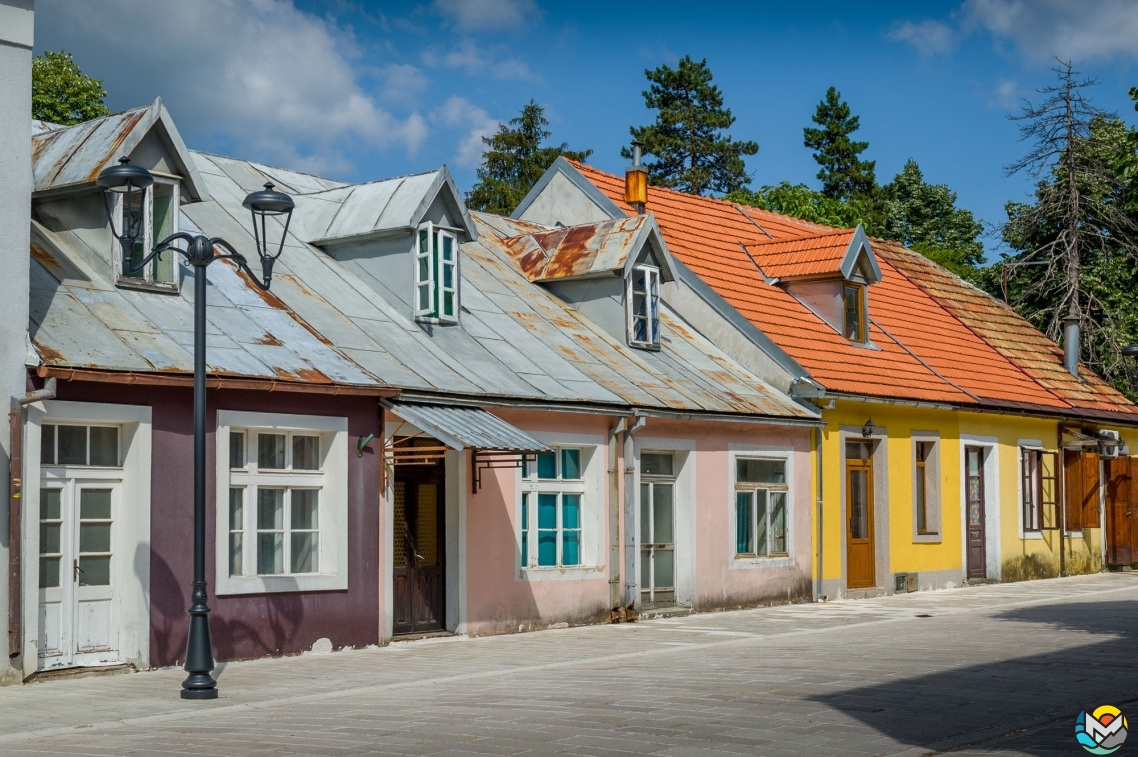
Small multi-colored houses trim the imposing mansions, that were built in the capital for the state and representative functions: banks, embassies, theaters, libraries. And given the modest size of the city, all this beautiful architecture clustered in a small area of the historic center, next to the ancient churches and the monastery.
The palace of King Nikola, the Ethnographic Museum, the monument to the founder of the city Ivan I Cernojević are on the main city square — the Palace Square.
On a main road to Cetinje stands an honorable monument: Lovćenska Vila — Spirit of Lovcen. It is a figure of a woman with a raised sword in one hand and a laurel wreath in the other. The monument is a memory of the events of World War I, when 300 Montenegrins from the United States tried to return to Montenegro to fight for the motherland. Their ship had blown up on a mine and sank near the coast of Albania.
Some particular buildings in the old capital deserve a special attention. When Montenegro gained it’s independence in 1878, foreign states started to open diplomatic missions in the country. Those grand buildings are well-kept, still with state emblems and commemorative plaques.
The Embassy of Austria-Hungary (Bayo Pivljanin Street) was built in 1898 by renowned architect Joseph Slade. The spacious house consists of ground floor and an attic, and along the north side of the structure, Roman Catholic chapel was added. Today it is the State Institute for the Protection of Cultural Monuments.
Picturesque French Embassy was designed in 1910 in Art Nouveau style by architect Auguste Pere. It’s facade is decorated with monochrom ceramic tiles and metalwork. There is a legend, that such an attractive mansion stands in Cetinje by the accident. French architect planned this mansion for Cairo and a modest building for Cetinje, but the projects got mixed up. Now the former embassy houses the Central National Library.
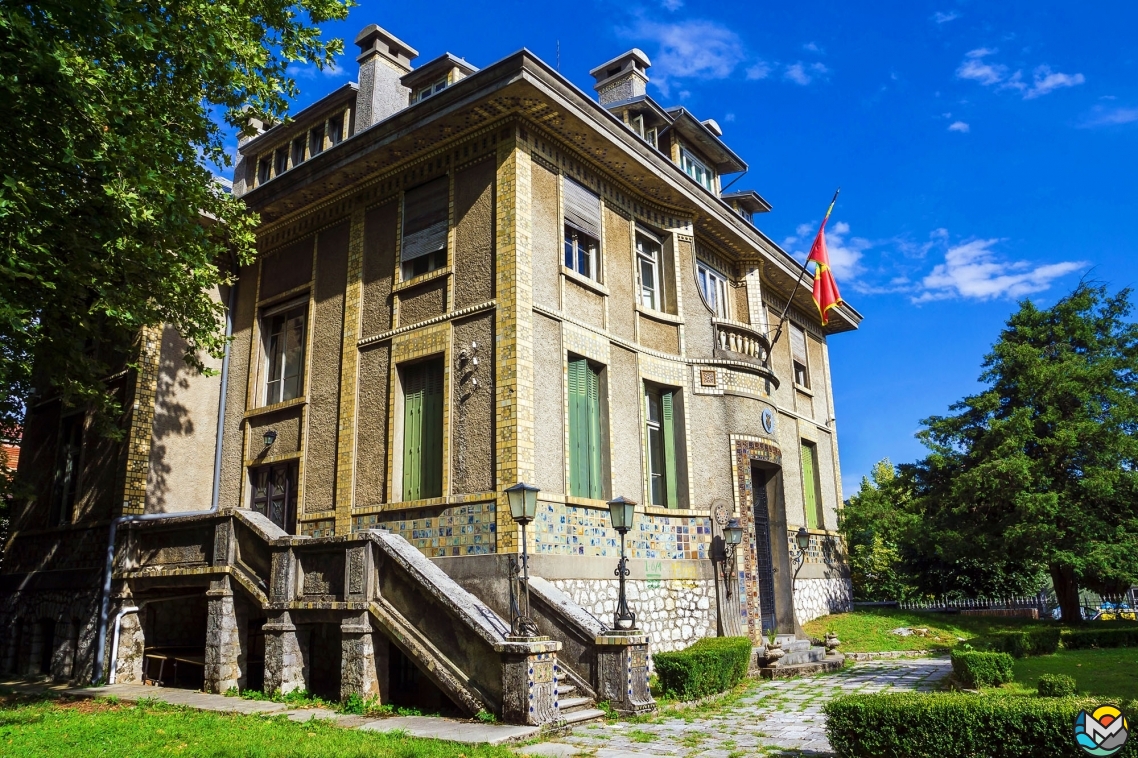
Elaborately built by Italian architect Corradini in 1903, the Russian Embassy is decorated outside with ornaments, fantastic creatures and garlands. No doubt, it is one of the most impressive buildings in Cetinje. Nowadays it is the Faculty of Fine Arts.
The same architect, Corradini, created the Italian Embassy on the outskirts of the capital. The graceful mansion, surrounded by a park, now accommodate a part of Central National Library.
The British Embassy stands on Negoseva street next to amazing Blue Palace, a current residence of the President of Montenegro. The Embassy is designed in traditional British tasteful and restrained style and today houses the Montenegrin Academy of Music.

The Ethnographic Museum seats in the former Embassy of Serbia. It is a beautiful building at the heart of Cetinje, previously belonged to the Serbian King Peter Karageorgievich.
The Turkish government bought an impressive house of Duke Maso Verbić to accommodate their diplomats. Now it is the University of Montenegro Faculty of Drama.
The vice-consul of Belgium, Vuc Vuletic, was a merchant and the owner of Cetinje’s hotel. The Belgiom embassy resided in his private house on Nogoseva Street. Now the building is owned by the descendants of Vuletic.
City’s favorite coffee shop — Gradska Kafana — dwells in the former Embassy of Bulgaria.
One of the most graceful old mansions in Cetinje, is the home of The Royal Theatre Zetski Dom, the oldest theater in Montenegro. It was built in 1884 by the architect Josiph Slade. The theater is working now and all it’s interiors have been restored to the original appearance. In addition to drama production and concerts, it deals with production of opera, publishing, education and organization of theatre festivals.
The Royal Theatre Zetski Dom is a part of The European Route of Historic Theatres.
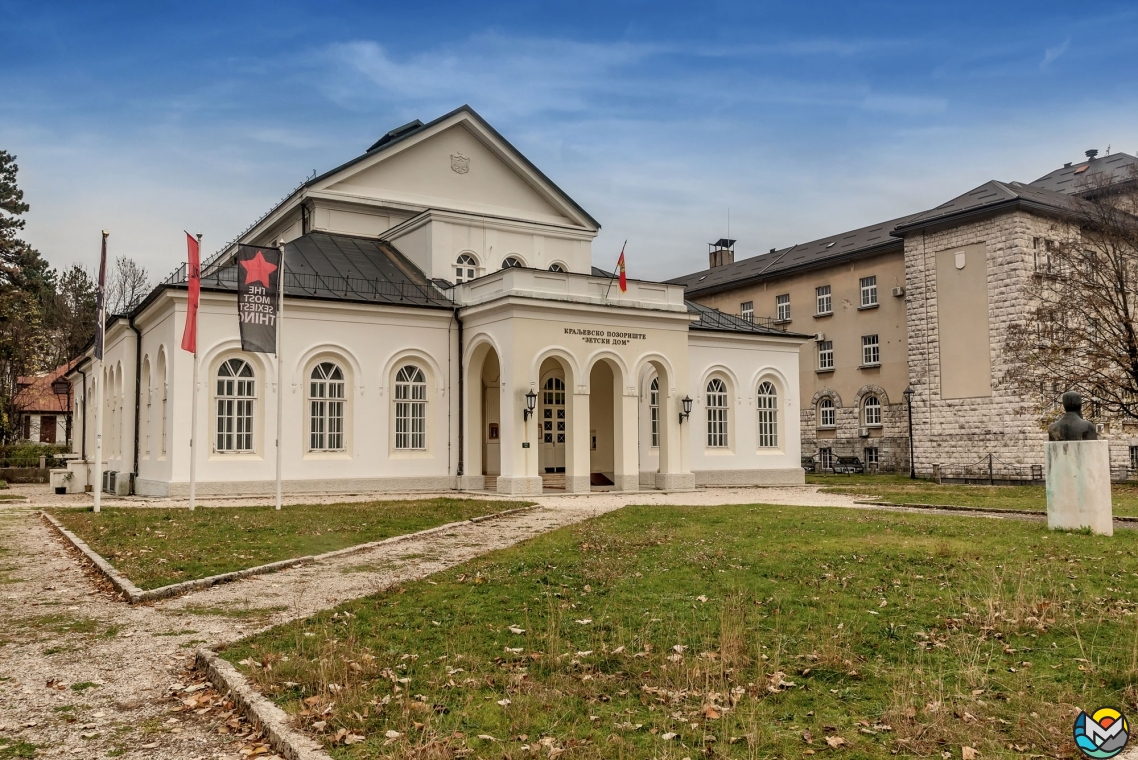
Parks
Cetinje’s parks are special either in summer or in winter.
At the end of the nineteenth century, two parks were set up on the both sides of Negoseva street: Park Negoseva in French style and Thirteenth of July Park in English style.
In early spring the parks are covered with a carpet of blooming crocuses, a truly unforgettable scene, that attracts many tourists.
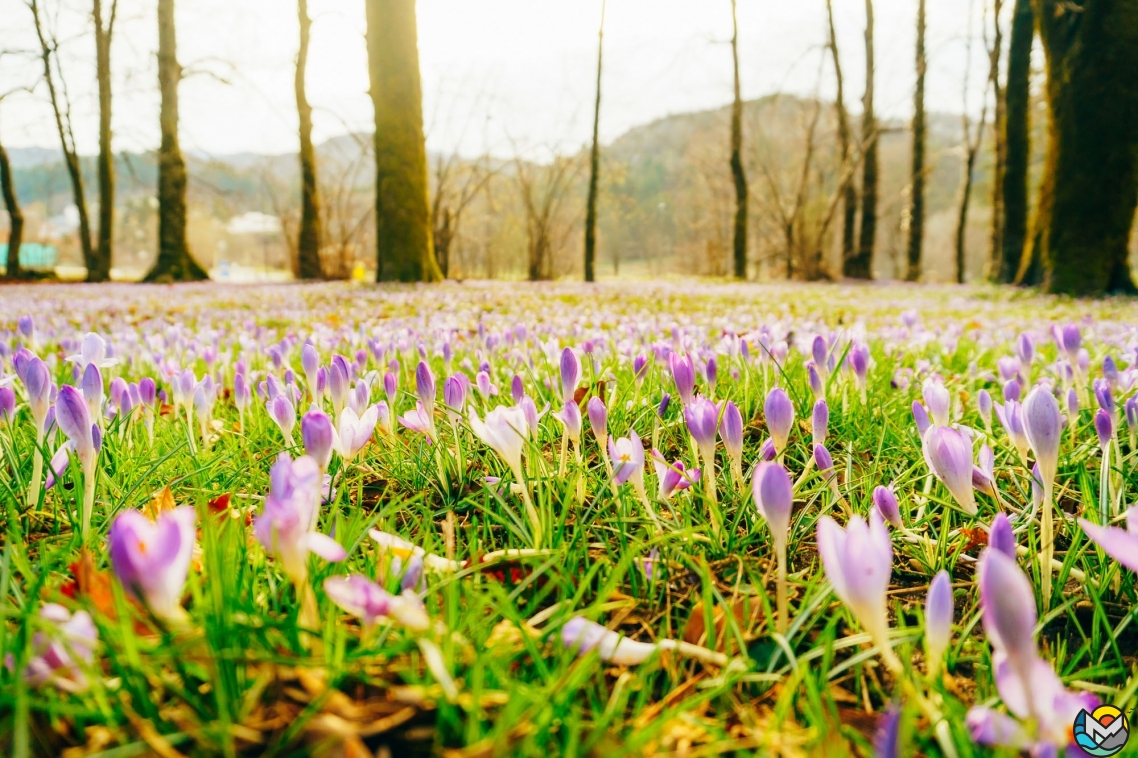
In summer, it is time for infamous Cetinje lindens to flower, and it is another reason to visit the old royal capital, drink coffee and inhale the aroma spreading throughout the city.
Not far from the Cetinje Monastery lays a beautiful park called Vladičina bašta.
If you are looking for souvenirs from the cultural capital of Montenegro, go to small shop at the Palace square. A cheerful blacksmith Bogdan Marcano makes horseshoes and bells there, while singing and dancing.
Entertainment
Cetinje is called the cultural center of Montenegro, and the city definitely deserves this title! It hosts many music and theater festivals, concerts, art exhibitions and so on.
In July and August, there is the Summer in the Capital festival, a unique mix of art forms — visual, performing and even literary art.
Every year the city welcomes the Espressivo classical music festival and Cetinje Jazz Fest festival.
Annual International Festival of Folklore focuses mainly on traditional music of the region and is very popular among the locals and tourists alike.
Vicinities
Cetinje is located at the foot of the Lovćen massif, in the Lovćen National Park. There is one of the most famous tourist places in Montenegro: on the top of Jeziersky Vrh mountain, at altitude of 1657 meters (5,436 feet) above sea level stands the mausoleum of Petar II Petrović-Njegoš, country’s favorite ruler, poet and philosopher.
Initially, Petar Njegoš was buried in a small chapel, on one of the peaks of Lovcen, but it was destroyed twice during the First and Second World Wars. In the middle of twentieth century Yugoslavian authorities decided to replace the chapel with a mausoleum. It was designed by architect Ivan Meštrović and remains in fabulous condition today.

To reach the mausoleum, you have to drive to Jeziersky Vrh mountain, then leave the car and climb 461 steps.
Lovćen’s second imposing peak, Štirovnik; 1,749 meters (5,738 feet) can be clearly seen from different parts of the Bay of Kotor.
Nearby sits a native village of the rulers from the Petrović dynasty, Njegoši. In the village you can visit the museum of Petrović family and get acquainted with mountain architecture and lifestyle.
And last but not least, Njegoši region produces traditional delicacies: Pršut — dry-cured ham, served uncooked, similar to Italian Prosciutto; cheeses, wine, honey and rakija — a strong alcoholic drink, local moonshine.
Lovćen National Park attracts thousands of visitors every year. It’s beautiful nature and moderate summer temperatures provide countless opportunities for outdoor activities.
For example, Adventure Park Lovćen in a small village of Ivanova Korita, has series of air paths with challenges designed for different ages and levels of physical fitness. Try your courage and endurance with the supervision of qualified instructors and highly trained staff.
Many hiking trails go from Ivanova Korita up to the mountains.
There are also equipped picnic areas in the Park, hotels and restaurants with local cuisine.
If you travel by car, you can drive through Cetinje to Lovćen National Park, see the mausoleum and go down to Kotor by unforgettable 26 serpentines road. This road was built, rather intricate, by the architect and engineer Joseph Slade in the 19th century.
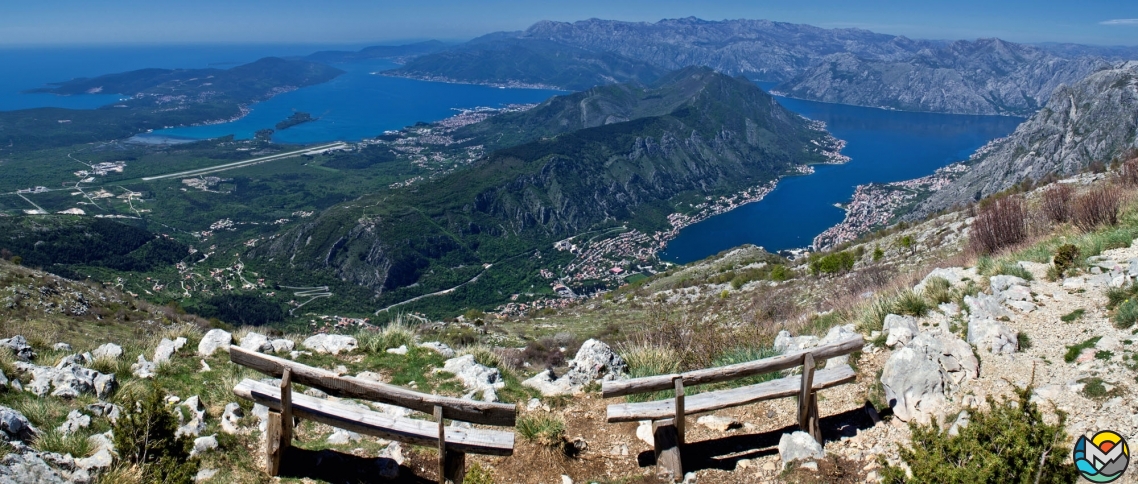
Despite the difficulties of this route, the bird’s eye views of Boka Bay will make your heart sing. There are many observation platforms on the way, you can see Kotor, Tivat, and the airport. Well-preserved old customs building marks the border between the Bay area belonged to Austria-Hungarian Empire and Montenegro. In the village of Trojica, the mountain road diverges: on the left it leads to Tivat, on the right — to Kotor.
Drive on this road on a sunny day, otherwise the panorama will be closed by clouds and fog, and, well, it is less dangerous.
Lipa Cave
Lipa Cave — Lipska pećina — at the Cetinje region is open for visitors from May to October. This is the first cave adventure in Montenegro offering a charming diversity of karstic features. A tour to the cave makes a strong impression with 2,5 kilometers (8202 feet) of illuminated passages and halls filled with stalactites, stalagmites and amazing natural pillars. Please bear in mind that the temperature inside is about 10 degrees Celsius even in the hottest season, so have some warm clothes if you plan to visit the cave.
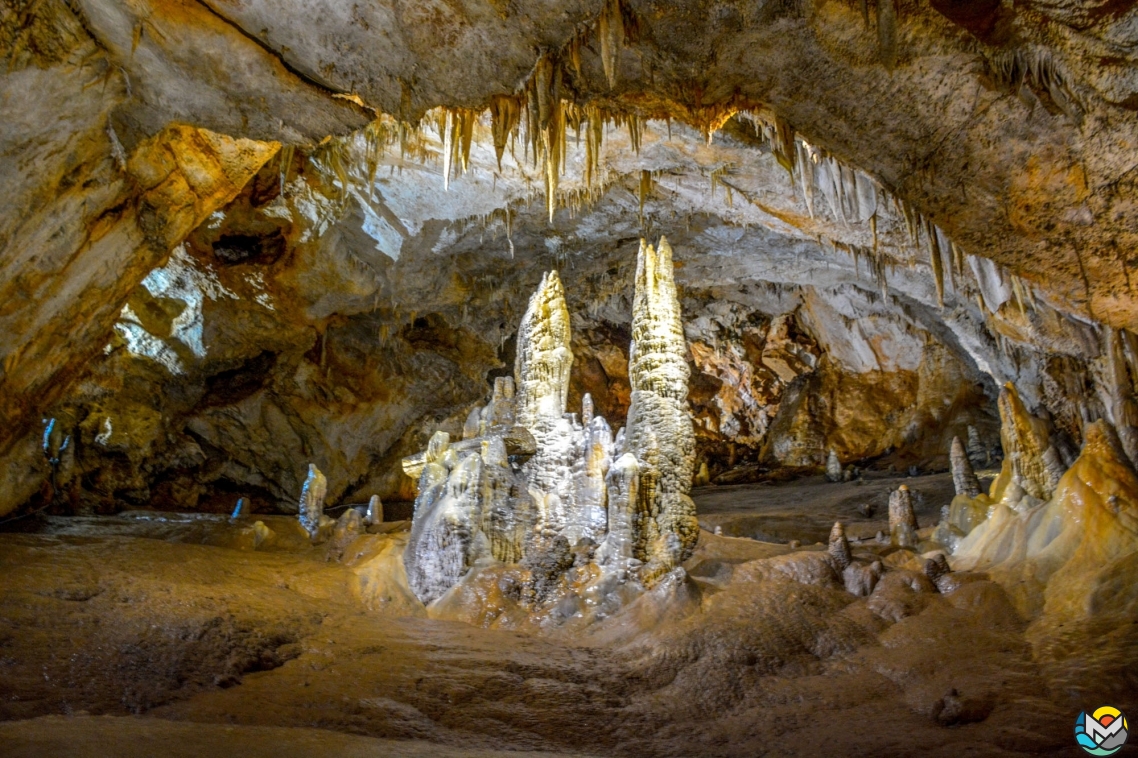
Tours take 60 minutes, including a road-train ride and short walk to the entrance.
Lipa Cave is located near the village of Lipa, 5 kilometers (3,1 miles) away from Cetinje. Take the Cetinje-Podgorica highway, make a turn to Belveder restaurant, then go in the direction of Lipa Dobrska and follow the signs.
Cafes and restaurants
Cetinje’s eateries offer the best old-fashioned Montenegrin dishes.
Belveder restaurant is designed like a cozy rural house with a large terrace overlooking the mountains and magnificent Lake Skadar.
Konak restaurant on the Cetinje-Budva highway has a vast vegetarian menu, which is rare in this meat-loving country.
At the city center you can find cuisines for every taste. Dvor on Palace Square is a pleasant place to enjoy, with a wide selection of wines and great traditional and Mediterranean food.
Located just a few hundred meters from the Palace Square, restaurant Kole captivates the guests by it’s calm and exquisite interior. The menu offers freshest tender fish from the Lake Skadar.
Nearby New York City Caffe serves burgers, pizza and sandwiches as good as American classic food gets in this town.
The beautiful coffee house, Gradska Kafana, located, as mentioned before, in the building of Bulgarian Embassy, and Scottish Pub Academia are stylish and atmospheric places at the heart of the city.

